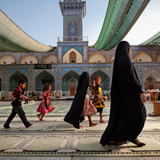I haven't returned to Baghdad to be a war tourist, attuning my eyes to the many long shadows cast by trauma, but it's difficult not to do just that. The last time I was here I wore desert camouflage and carried an M4 carbine as a sergeant in the U.S. Army's Second Infantry Division. That was in 2003 and 2004, when there were up to 150,000 U.S. troops in Iraq. In the years since, I've often wondered what it must be like for Iraqis struggling to reclaim a life for themselves: the welder, the student, the taxi driver, the old woman, the couple getting married. I've also wondered how it would feel to walk down a Baghdad street without a flak vest and 210 rounds of ball ammunition strapped to my chest.
Back then, my unit escorted long, serpentine supply convoys through the city. Insurgents staged complex ambushes, driving cars loaded down with explosives. The black scorch marks of vehicles burned to the ground remained long after their hulks were removed, giving me pause whenever we passed them by. One day our squad leader yelled at my machine gunner and me to drop down from our positions in the hatches at the rear of our Stryker vehicle—and mortar rounds suddenly burst in the air, raining down a deadly spray of shrapnel. We rode through the storm of metal, hearts pounding in our chests. Memories like these reenact themselves in my mind now as we drive through the city, and for a moment I imagine I've returned to Baghdad the way a ghost might haunt the world it once inhabited.
But things have changed. This isn't the Baghdad I once knew. Just off Abu Nuwas Street near the Tigris River, where sniper fire was once a daily hazard, the sounds of war have been replaced by the sounds of children playing soccer on the grass. They whoop, high-pitched and full throated, like birds calling to each other. On Haifa Street, where bitter sectarian fighting raged from 2006 to 2008, young men pause in the doorway of a local market to finish a conversation as Iraqi pop music blares from a boombox. Near the university several young women laugh as they cradle textbooks and notebooks, their head scarves a splash of color against the drab building facades. Everywhere around Baghdad there is the sound of a city regaining its voice.
When I stepped off the plane, collected my bag from the luggage belt, and walked out into the city, I didn't know what to expect. It was late December 2010. News reports of targeted assassinations via silencer-equipped pistols occupied my thoughts. I couldn't dismiss the possibility of being kidnapped. But as much as my fear counseled me to jump back on that plane, I wanted to know what had become of this place where I'd once come to war. If I was going to meet the new Baghdad, I'd have to put some old habits and memories to the side.
A City of Walls
My first day back I spread out a map of the city on a table in a shaded inner courtyard. It's an outdated map with many red and blue adhesive dots placed on various parts of the city. Many of the names of neighborhoods have changed since the invasion. Saddam City, as it's listed on my old map, for example, now goes by Sadr City, after the deceased Shiite leader Muhammad al Sadr. The dots create an overall pattern as I step back for a bird's-eye view: blue to one side, red to the other; Shiites dominating the eastern side of the Tigris, Sunnis clustered on the western. The Sunnis have pushed farther west as Shiites have made inroads into neighborhoods adjacent to the river. Although there are still a few mixed neighborhoods, Baghdad is no longer a model secular city of the Middle East, as Iraqis once proudly described it. Years of violence have created a new landscape defined by tribe and religion.
With a population of nearly six million, Baghdad has become a city of walled enclaves regulated by Iraqi Army troops, federal police officers, local policemen, private security guards, and other groups such as the Sons of Iraq, who are like your local Neighborhood Watch crew, only armed with AK-47s. The demarcations are formed by massive concrete blast walls known colloquially as T-walls because they resemble giant T's flipped upside down. Religious flags wave from rooftops, mosques, and intersections in predominately Shiite areas. Sunni neighborhoods are marked by a lack of flags.
"Baghdad is a huge camp, man," says my interpreter, Yousif al-Timimi. "America didn't bring democracy. It brought walls."
The River Taxi
One morning I take a water taxi out onto the Tigris River with a boatman named Ismail, who tells me that he inherited his trade from his father in a tradition stretching back for generations. As he steers the prop with his left hand and talks about his life, I try to push to the back of my mind the fact that we're out in the open, in a clear field of fire, and that a sniper could be in a hide right now debating the physics of his ballistic art—steeped in the contemplation of the elevation and windage, the slight breeze I now feel in my hair, the pitch and yaw of the boat as it slices upriver through the waves, the humidity in the air between us.
And so I focus on the Tigris as it winds its way through the heart of Baghdad. It's a wide river with an unassuming surface of sunlight and shadow, a storied river that doesn't advertise the inexorable pathos transported in its depths. In the winter of A.D. 1258, when the Mongols sacked Baghdad under Hulegu Khan, great destruction was visited upon the city and its inhabitants. The Bayt al Hikma, or House of Wisdom, was plundered, its contents thrown into the Tigris—philosophical tracts and treatises, art, poetry, historical tomes, scientific and mathematical works—the intellectual wealth of centuries. When the Mongols were done pillaging, it's been said, the Tigris ran black with ink.
More recently, it flowed with bodies. In the winter of 2004 soldiers from my battalion manned a johnboat to search an island upriver in the city of Mosul, where a mortar firing position was rumored to be. The boat capsized, and weighed down by their equipment, one soldier and three Iraqi policemen disappeared into the water. My company helped cordon off the riverbanks so that patrol boats and Navy divers could recover their bodies. Before they could find them, the search teams pulled up the bodies of a student from Kirkuk and an Iraqi policeman we weren't even looking for. As I sit in Ismail's water taxi, I'm hesitant to reach over and put my hand into the water. The Tigris has become a kind of graveyard; it deserves respect.
I take a series of photographs. Iraqi Army soldiers materialize from their posts under the bridge abutments and order us to shore. We're briefly detained and questioned by the local commander, who stands in the doorway of a guard shack wearing only a bemused expression and thermal underwear, his combat boots left unlaced, a tiny cup of Arabic coffee in his hand. He orders us not to take any more pictures of the bridges and then releases us. Before we can go, one of the soldiers insists I share from his plate of scrambled eggs. He tears his flatbread in two and shoves a piece into my hands with a smile.
Back out on the Tigris, Ismail tells me there was an incident last week involving a magnetic "sticky" bomb, and that it may also have involved a water taxi. The Iraqi military keeps a vigilant eye on the river. Which makes me wonder how Ismail is able to make a living under such conditions. When were the good times? I ask.
Ismail responds, "Good times?"





 Ancestry.com
Ancestry.com Buy NG Photos
Buy NG Photos Special Issues
Special Issues